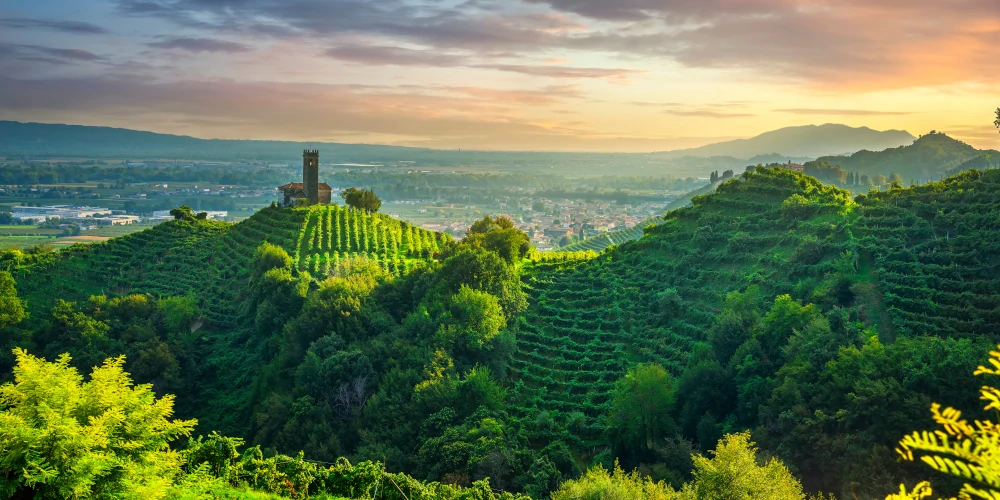
Guide to Prosecco wine
How to choose the best Prosecco wine: use this “Guide to Prosecco wine” to learn everything you need to know about Italy’s most successful sparkling wine.
Made using the tank method, Prosecco has youthful, fruity flavours like pear, peach, melon, honeysuckle and jasmine. Prosecco has high acidity and low to medium levels of alcohol.
The name ‘Prosecco’ is protected by law, so this sparkling wine can only be made in certain appellations. Prosecco DOC is the largest, covering the north of Veneto and all of Friuli Venezia Giulia. Conegliano Valdobbiadene – Prosecco DOCG and Asolo Prosecco DOCG both sit upon hills in the province of Treviso. These appellations are famous for premium wines with more concentrated flavours. Superiore di Cartizze is considered the highest quality Prosecco on the market.
Prosecco is not better nor worse than Champagne. The difference is that these two famous sparkling wines are produced using different methods. Prosecco is prized for its fresh and fruity primary flavours, whereas Champagne is enjoyed for its complex secondary notes of toast and brioche.
Table of contents
What is Prosecco?
Prosecco is a dry or off-dry sparkling wine made using the tank (Martinotti) method. The process starts in stainless steel tanks, where CO2 bubbles form naturally in the wine. Prosecco makers aim to preserve the natural aromas of the grape, so the resulting wines burst with youthful, fruity flavours. Common tasting notes include pear, peach, melon, honeysuckle, jasmine and pear drop candy. It has high acidity and low to medium levels of alcohol (10-12% ABV).
Prosecco Rosé is a fragrant sparkling rosé wine with a delicate pink hue. It has aromas of wild strawberry, cranberry, fresh raspberry, and often has a sweet smell of candy. The blush colour and red fruit flavours come from the addition of Pinot Nero grapes.
An excellent example is this Prosecco Rosé from Treviso that I personally selected for our store. It’s so good, we sent it to some of the best wine journalists to review. I was really delighted because they liked this wine as well, and then wrote about it in Decanter magazine and in Forbes. It’s a dry (Brut) Prosecco with vibrant flavours of red fruits – with a touch of peppery spice.
The name ‘Prosecco’ is protected under EU law, which mean it can only be made in strictly defined areas in north-east Italy (Prosecco DOC, Conegliano-Valdobbiadene Prosecco DOCG and Asolo-Proseco DOCG).
Prosecco can be made in two styles: fully sparkling (spumante), or lightly sparkling (frizzante). Spumante offers more persistent bubbles, as the gas in bottle is under higher pressure (4-6 bar). Prosecco frizzante has a finer mousse with tiny bubbles, and a much lower pressure (1-2.5 bar).
The vast majority of Prosecco is made in the spumante style. When made in the Conegliano-Valdobbiadene area, spumante wine can be called Prosecco Superiore.
Is Prosecco sweet or dry?
Prosecco is made in varying levels of sweetness. From dryest to sweetest, these are Zero, Extra Brut, Brut, Extra Dry and Dry. Most Prosecco wine is produced in the Brut (dry) or Extra Dry (off-dry to semisweet) style.
This naming can be quite confusing – basically if you want a sweeter Prosecco, look for ‘Dry’ on the label, and if you want a bone-dry Prosecco look for ‘Brut’.
If you don’t like any hint of sugar in your sparkling wine, look out for the very crisp, low-sugar versions of Prosecco: Zero and Extra Brut. These wines have sharp acidity and less than 5 g/l of residual sugar.

Personally, I choose Prosecco based on the occasion and whether I’ll be having any food or not. If I’m drinking Prosecco with white fish or sushi, I prefer a dry version: either Extra Brut or Brut. This lovely Millesimato from Ca’ di Rajo is ideal for seafood dinners.
However, if I’m planning to sip Prosecco on its own – as a party drink, or as an aperitif – I’d go for a slightly sweeter version with lush aromas of ripe fruits. In this case my choice would be a sweet (Extra Dry) Prosecco.
How is Prosecco different from Champagne and other sparkling wines?
Prosecco is produced using the tank method. It doesn’t spend any time ageing on its lees (dead yeast cells). This preserves the natural freshness of the grape to create lively, youthful wines intended to be drunk young. They have fruity flavours of pear, peach, melon and candy.
Read more about how the tank method works.
Champagne, on the other hand, is produced using the traditional method. The first fermentation also happens in tanks, but then the wine undergoes a second fermentation in bottle. It stays in the same bottle for several years, in contact with its lees (dead yeast cells). This adds complex flavours of bread, biscuits or brioche. Italian wines crafted in the same way include Franciacorta, Alta Langa DOCG and Trento DOC.
One method is not better than the other. These wines are made in different ways and are intended to taste different. Whether you think Champagne or Prosecco is best is down to personal preference.
Which grapes is Prosecco made from?
The main grape used to make Prosecco is Glera. It must constitute at least 85% of the wine. Winemakers can add up to 15% of other grapes to create a unique house style. Permitted grapes are Verdiso, Bianchetta Trevigiana, Perera, Glera Lunga, Chardonnay, Pinot Bianco and Pinot Grigio.
One red grape, Pinot Nero (Pinot Noir), can be added too – as long as it’s vinified as a white grape (i.e. without skins). It is also used to give the delicate Prosecco Rosé its signature hue and red berry flavour.
Glera: the grape behind Prosecco’s success
Glera is a semi-aromatic grape native to Friuli Venezia Giulia. The berries of Glera are round, and of medium size. When fully ripe, they have an attractive golden-green colour, often with small dark dots. [MiPAAF]
Until 2009, Glera was known under the official name ‘Prosecco Tondo’. It is thought to originate from the town of Prosecco in Trieste (part of Friuli Venezia Giulia). As often happens, the same grape is known under different local names. In Padova (south Veneto), the locals knew it as “Serprino”. The name “Prosecco” was typical throughout the rest of Veneto, while in Friuli Venezia Giulia it was known as “Glera”.
In 2009, several Prosecco-producing IGTs in Veneto and Friuli Venezia Giulia were combined to form a new, higher-quality denomination: Prosecco DOC. It meant that all winemakers had to adopt a single winemaking rulebook (Disciplinare di Produzione). This was an important milestone for the quality of Prosecco, because now sparkling wine from across north-east Italy was made in the same consistent way.
At the same time, the appellation of Conegliano-Valdobbiadene Prosecco DOC was elevated to the DOCG status – recognising the consistently high quality of its wines.
Why was the Prosecco grape renamed to Glera?
The difficulty with the grape and sparkling wine sharing the same name is that the valuable brand ‘Prosecco’ couldn’t be legally protected. Any producer from another part of Italy – or anywhere in the world – could grow the Prosecco grape, and call their wine Prosecco.
European law allows a wine name to be protected if it’s connected to a geographical place. Legally, such wine is known to have a protected designation of origin, or PDO for short. Famous examples include Champagne (this word can be printed on a label only if a wine comes from the French township of Champagne), Barolo DOCG (wine from the region in Langhe hills of Piemonte), etc. However, a grape name cannot be protected, so it can be used on labels anywhere around the world.
This is why the Prosecco grape had to be renamed. In 2009, its official name was changed to the Friulian version: “Glera”. What’s more, Prosecco DOC expanded its borders to include the town of Prosecco, which until that time was never part of any pre-existing Prosecco IGT.
Where is Prosecco wine made?
By law, Prosecco comes from the north-east of Italy: the provinces of Veneto and Friuli Venezia Giulia, to be precise. The official production areas for Prosecco are Prosecco DOC, Asolo-Proseco DOCG and Conegliano-Valdobbiadene Prosecco DOCG.
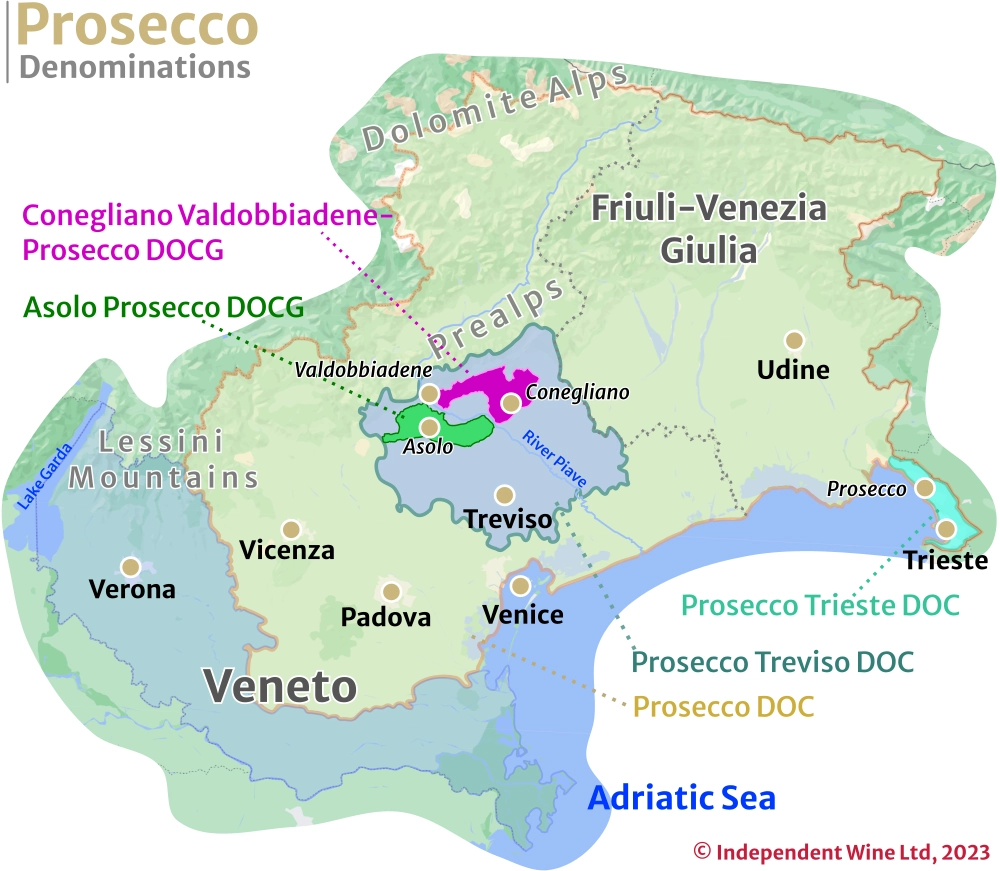
Each Prosecco production area has its own particular conditions – from breezy Alpine mountain slopes to humid plains on the Adriatic coast. As a result, the wines offer quite different flavour profiles and quality levels.
This ‘Pyramid of Prosecco’ diagram clarifies the difference between the quality and price.
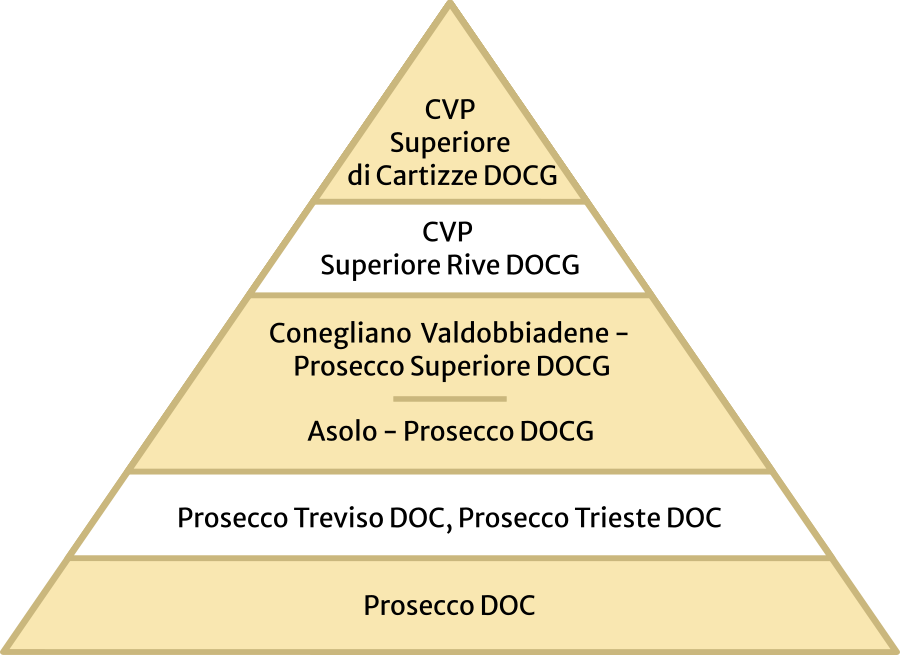
Let’s find out how they differ.
Prosecco DOC
Prosecco DOC is Italy’s most successful sparkling wine denomination. With over 400 million bottles produced each year, it’s the most productive area for this joyful sparkling wine [2, 2020]).
What does Prosecco DOC wine taste like? Prosecco DOC is refreshing, with delicate aromas of green pear, peach, melon and white flowers. Although the lightly sparkling style (frizzante) is allowed, the most popular style is fully sparkling (spumante), with persistent bubbles.
The territory of Prosecco DOC covers five provinces in north Veneto, and four in Friuli Venezia Giulia.
Veneto: Belluno, Vicenza, Venezia, Treviso, Padova
Friuli-Venezia Giulia: Gorizia, Trieste, Pordenone, Udine
Sparkling wine that comes from the provinces of Treviso and Trieste can be labelled Prosecco Treviso DOC and Prosecco Trieste DOC respectively.
The Prosecco DOC area is so large that climate and growing conditions vary vastly.
A large number of wineries in Veneto and Friuli Venezia Giulia grow grapes on the plains near the Adriatic coast. Here, the winters are mild, while summers are warm and humid. The rivers Piave and Tagliamento have created alluvial plains with rich and productive soil. Wines are produced in large quantities, typically in the easy-drinking, lightly floral style which is so popular with consumers.
Two production areas for Prosecco DOC wine are especially unique. The natural grape-growing conditions are very distinct from the rest of the denomination. As a result, they get their own special mention on the label: Presocco Treviso DOC and Prosecco Trieste DOC.
Prosecco Treviso DOC
These hilly and mountainous areas of the province of Treviso lie inland. Grapes from such vineyards have higher natural acidity and more complex flavours. Hillside wineries produce high-quality Prosecco with crisp acidity and fresh flavours. Hills are more difficult to cultivate, and the resulting wines are naturally more expensive. (The most premium Prosecco denominations of Asolo and Conegliano-Valdobbiadene are found in this area, too.)
Prosecco Trieste DOC
The province of Trieste offers very favourable growing conditions for high-quality grapes. The limestone plateau has very poor topsoil, with high chalk and iron contents. The area is cool and dry, with little rainfall and the strong influence of Bora – cold wind from the Balkan peninsula. As well as Prosecco, this area is responsible for some of the best Italian white wines.
Conegliano Valdobbiadene – Prosecco DOCG

Conegliano Valdobbiadene – Prosecco DOCG is known to produce high-quality Prosecco wine with concentrated flavours. Vineyards are planted on steep mountain slopes, and grapes retain more acid and develop complex aromas. Conegliano Valdobbiadene – Prosecco has crisp acidity, flavours of green pear, ripe yellow apple, stone fruit, and white flowers, complemented by a persistent mousse. This wine often commands a substantially higher price than standard Prosecco DOC.
The DOCG area lies 25 km north of Venice, on the slopes of the Venetian Prealps (also called Belluno Prealps). It stretches 20 km between the towns of Valdobbiadene and Conegliano.
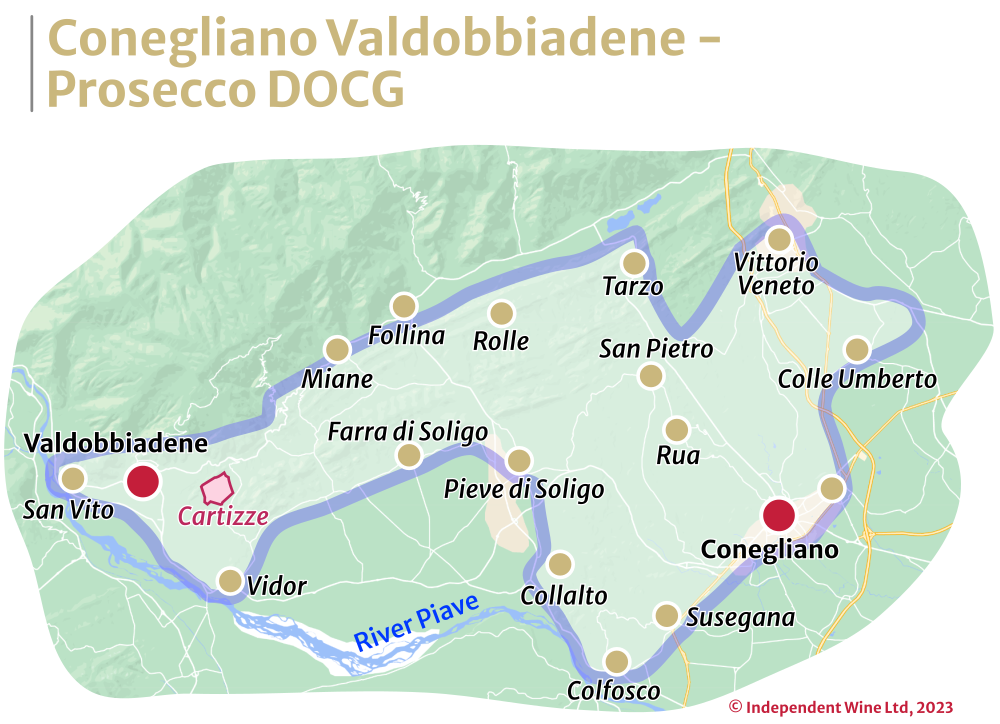
Prosecco’s historic birthplace
The Conegliano Valdobbiadene area is the historic birthplace of this legendary vino spumante. Around 1896, Antonio Capernè developed the method to produce sparkling Prosecco, and was the first to release this wine on the market.
The appellation received official recognition in 1969 as DOC, and in 2009 was promoted to DOCG status.
DOCG stands for denominazione di origine controlata e garantita. This means that Conegliano Valdobbiadene – Prosecco DOCG is made to much stricter winemaking rules than Prosecco DOC.
Which wine styles are permitted?
The official winemaking rulebook of Conegliano Valdobbiadene – Prosecco permits two styles:
- Frizzante (lightly sparkling, fine foam);
- Spumante (fully sparkling, persistent bubbles).
The lion’s share of wine is produced as spumante. It is important to note that spumante wine from this region is labelled ‘superiore’, as so: Conegliano Valdobbiadene – Prosecco Superiore DOCG.
Understanding the label
On the label, wines from this area can be called by the full name, or a shortened version:
- Conegliano – Prosecco DOCG, if the wine is produced close to the comune of Conegliano
- Valdobbiadene – Prosecco DOCG, if the wine is from the side of Valdobbiadene
The term “Superiore”: wine is made in the spumante (fully sparkling) style.
“Millesimato” is single vintage Prosecco. If you see this term on the label it means that this wine is made from grapes harvested in the same year. This is notable because it’s a standard practice in sparkling wine production to blend wines from previous years to achieve the desired house style.
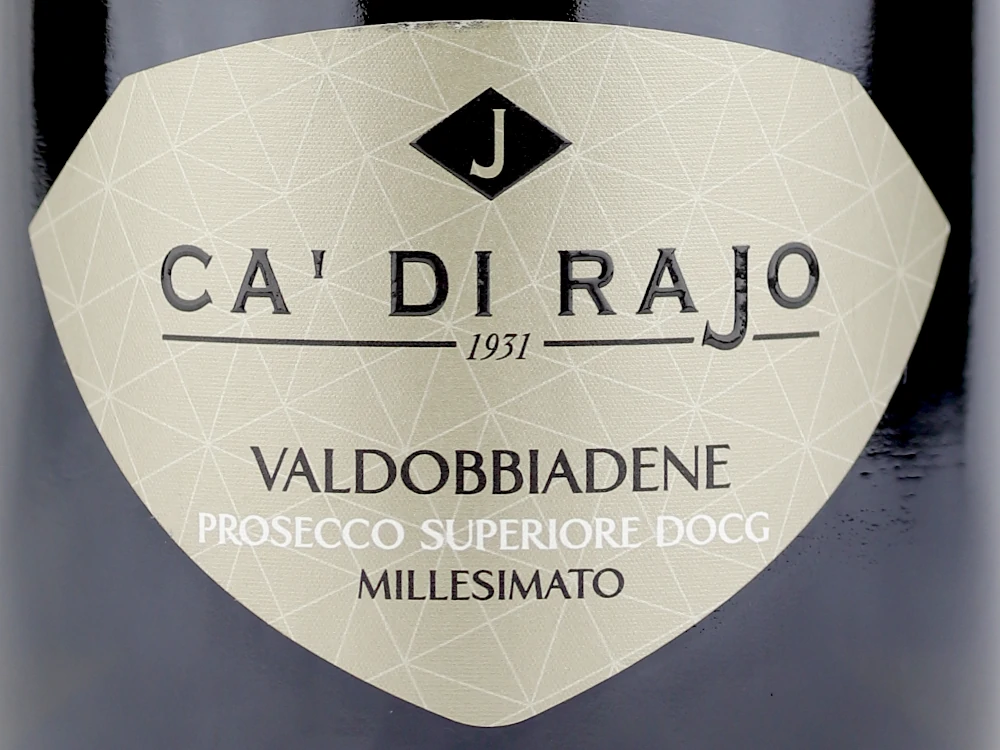
Which grapes are allowed in Conegliano Valdobbiadene – Prosecco?
Just like in the Prosecco DOC area, wine must be made from at least 85% Glera. Up to 15% can be made up from Italian white grapes (Verdiso, Bianchetta Trevigiana, Perera or Glera Lunga) or international grapes, which are now traditional in the area (Pinot Bianco, Pinot Nero, Pinot Grigio and Chardonnay). They are often added to make a unique house blend.
What makes Conegliano Valdobbiadene – Prosecco so special?
The most important difference is that Conegliano Valdobbiadene – Prosecco comes from a smaller area, south of the Dolomite Alps. In the Conegliano Valdobbiadene area, vineyards are planted on the slopes of Venetian Prealps. This area has a unique microclimate. It receives a lot of sunshine, with cool mountain breezes to moderate the temperature.
The Prealps – a range of hills and mountains as high as 1500 metres – protect Conegliano Valdobbiadene from cold winds blowing down from the Dolomite Alps in the north. The Adriatic sea in the south is close enough to ] keep the air temperature mild. As a result, the Glera grape can ripen better than in any other part of Veneto whilst retaining its acidity and aromatic complexity.
The growing environment of Valdobbiadene is influenced by the mountains. Vineyards are mostly planted on the south-facing slopes, sometimes as high as 500 metres above sea level. Prosecco from here has sharper acidity, with notes of green apples and white flowers.
Conegliano, on the other hand, is surrounded by gentle small hills of 200-300 metres in altitude. This area receives warm Adriatic air, and its wines have supple flavours of ripe pear, peach, melon and yellow flowers.
Superiore di Cartizze
Superiore di Cartizze is considered the finest Prosecco. The Cartizze valley is tiny, measuring only about 1.5 by 1.5 km. It lies 2 km east of the town of Valdobbiadene. It is the only subzone (sottozona) of Conegliano-Valdobbiadene Prosecco DOCG. The western wall of the valley is the range of hills between Santo Stefano and Saccol. Its eastern border is the road Soprapiana – Follo – Santo Stefano.
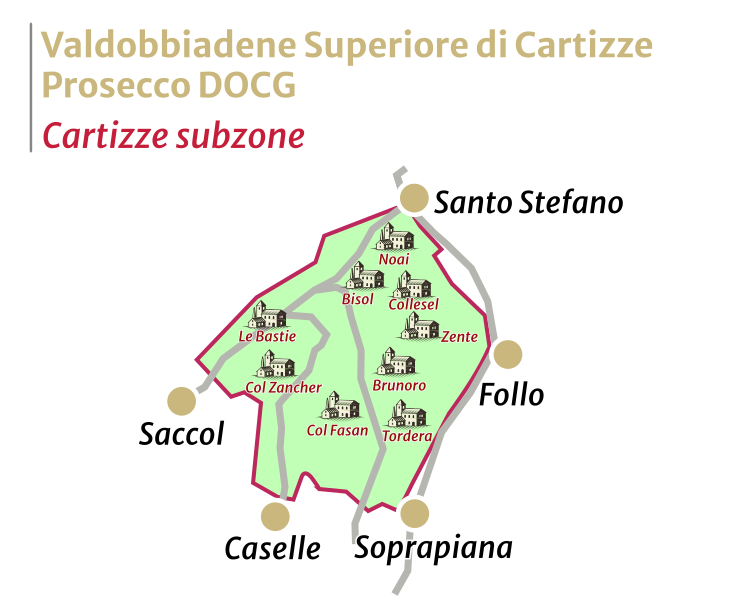
On the label, this version of Prosecco is typically called Valdobbiadene – Prosecco Superiore di Cartizze DOCG. Although Conegliano Valdobbiadene – Prosecco Superiore di Cartizze DOCG is also possible.
The Cartizze valley is essentially a natural amphitheatre formed by ranges of very steep hills. Vineyards are planted on south-facing slopes. Grapes can only be harvested by hand. In Cartizze, the disciplinare permits the lowest possible yields among all versions of Prosecco. This means that winemakers have to pick only the vey best berries to produce their Superiore di Cartizze wine.
What does Superiore di Cartizze Prosecco taste like?
While Conegliano-Valdobbiadene Prosecco DOCG is one step above standard Prosecco DOC, Cartizze Superiore is even better. It has highly concentrated and complex aromas with flavours of jasmine, honeysuckle, grapefruit rind, yellow apple, ripe pear and almond.
For the Italian market, Superiore di Cartizze Prosecco is finished in an off-dry style (which is marked as ‘dry’ on the label). In recent years, to cater for export markets which prefer dry wines, wineries have started releasing Cartizze Brut. It’s even possible to find bone-dry Cartizze Zero, with only 0.5% residual sugar.
Rive
Rive means ‘vineyard on steep slopes’. This word is used to identify 43 cru vineyards within the Conegliano Valdobbiadene area. This additional label is designed to promote the particular character and flavour of the wine, specific to the given Rive. Wines that hail from these cru vineyards are considered some of the best expressions of Prosecco.
On the label, the Rive is found at the end of the naming designation. For example: Conegliano Valdobbiadene Prosecco Superiore DOCG Rive di Rolle.
Rive vineyards in the Conegliano Valdobbiadene area
| Comune di Valdobbiadene Rive di San Vito Rive di Bigolino Rive di San Giovanni Rive di San Pietro di Barbozza Rive di Santo Stefano Rive di Guia Comune di Vidor Rive di Vidor Rive di Colbertaldo Comune di Miane Rive di Miane Rive di Campea Rive di Combai Rive di Premaor Comune di Farra di Soligo Rive di Farra di Soligo Rive di Col San Martino Rive di Soligo Comune di Follina Rive di Follina Rive di Farrò Comune di Cison di Valmarino Rive di Cison di Valmarino Rive di Rolle Comune di San Vendemiano Rive di San Vendemiano Comune di Colle Umberto Rive di Colle Umberto | Comune di Pieve di Soligo Rive di Pieve di Soligo Rive di Solighetto Rive di Barbisano Comune di Refrontolo Rive di Refrontolo Comune di San Pietro di Feletto Rive di San Pietro di Feletto Rive di Rua Rive di Bagnolo Rive di San Michele Rive di Santa Maria Comune di Tarzo Rive di Tarzo Rive di Resera Rive di Arfanta Rive di Corbanese Comune di Susegana Rive di Susegana Rive di Colfosco Rive di Collalto Comune di Vittorio Veneto Rive di Formeniga Rive di Cozzuolo Rive di Carpesica Rive di Manzana Comune di Conegliano Rive di Scomigo Rive di Ogliano |
Asolo Prosecco DOCG or Colli Asolani Prosecco DOCG
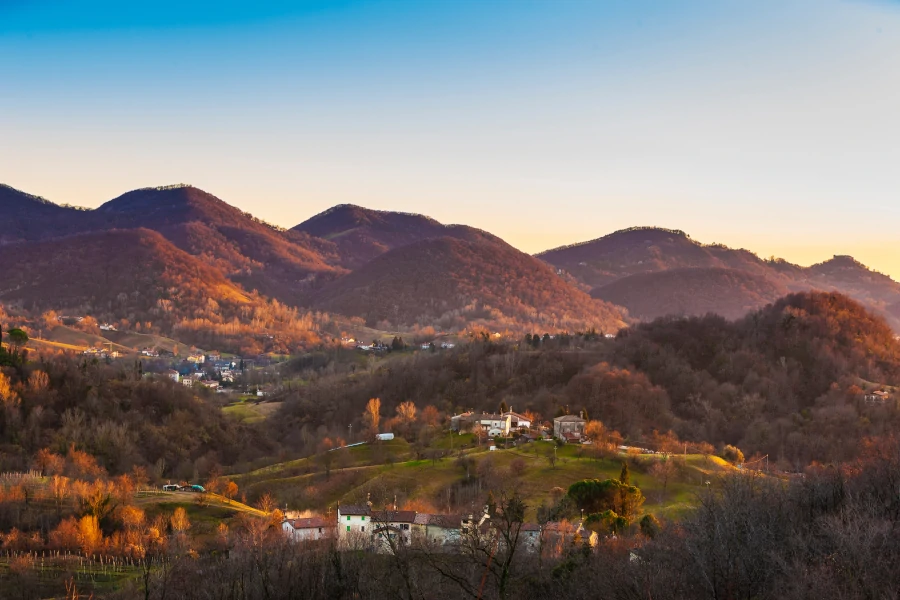
The Asolo wine appellation covers two ranges of hills: Colli Asolani (the Asolo hills) and Montello. They lie on the right bank of the Piave river, opposite the comune of Valdobbiadene. The Asolo hills aren’t as high as those in Valdobbiadene, with vineyards planted at altitudes between 200-300 metres.
Colli Asolani lie in the foothills of the Venetian Prealps. With peaks as high as 1000-1500 metres (Monte Cesen 1570 m), these mountains play an important role in protecting the area from the northerly winds. The weather in the Asolo hills is milder than in Valdobbiadene. As a result, the grapes develop into ripe, supple wines with richer aromas. Expect flavours of yellow apple, ripe peach, Cantaloupe melon, banana, daffodil flower, and vanilla.
Asolo Prosecco DOCG includes the large Montello hill that lies on the bank of the Piave river. It’s also home to a red wine denomination: Montello DOCG. It is known for its bold and structured wines made from Merlot, Cabernet Franc and Carmenère. These have excellent ageing potential.
How is Prosecco wine made?
Tank method
Tank method is used to produce lively, aromatic wines such as Prosecco and Asti. The wine is initially made in large stainless steel tanks which can hold high pressure. The vast majority of Italian sparkling wine is produced via tank method.
How is tank method different from traditional method?
Because of the rapid production process, the wine only stays in contact with its lees for a very short time. The resulting sparkling wine is fruity, vibrant and fresh without any of the bready notes you’d find in a lees-aged wine. Tank method wines are not designed for long ageing, and should be consumed young.
Tank method is less labour-intensive and time-consuming than the traditional method. For this reason, the production cost is cheaper. This method allowed Italy to make the less expensive, fruity Prosecco an international success.
How tank method works
First, the white grapes are crushed and pressed. The free-run juice is poured into a stainless pressure tank called an autoclave. The first fermentation creates so-called “base wine”, with a lower level of alcohol.
After the base wine is fermented, yeast and sugar are added to the same tank. This kicks off the second fermentation. As yeast converts sugar into alcohol, it naturally produces CO2 as a by-product. The gas isn’t released, but rather trapped in the tank. This gas goes on to add the desired bubbles to the sparkling wine.
As the fermentation process goes on, the pressure of CO2 increases. After it has reached the set level – usually 4-6 bar – the wine is filtered and bottled under pressure. Bottles are immediately released on the market, without ageing.
Origins of tank method
In Italy, tank method is known as metodo Martinotti, while in France it is called the Charmat method. It was developed and patented in 1895 by Federico Martinotti, director of the Experimental Oenology Institute (the Istituto Sperimentale per l’Enologia di Asti). The work was conducted in Asti, Piemonte. Eugène Charmat, the French inventor and winemaker, developed this method further, and registered a new patent in 1907. Elsewhere in the world, tank method is sometimes called metodo Italiano.
References
[1] MiPAAF. Ministero delle Politiche Agricole Alimentari e Forestali
[2] ISMEA Mercati, Istituto di servizi per il mercato agricolo alimentare. 3,002,120 hectalitres bottled in 2020, equivalent to 400 million 283 thousand bottles.



